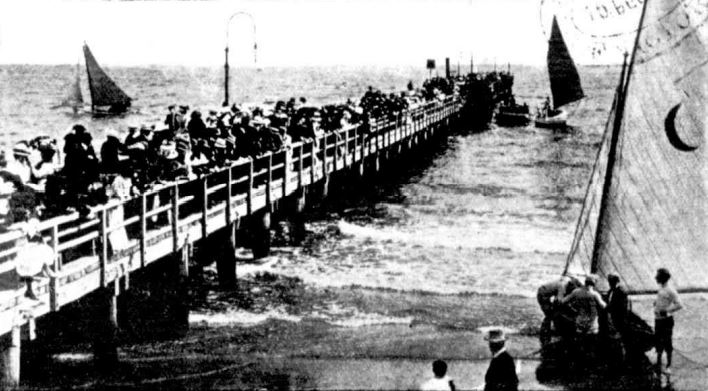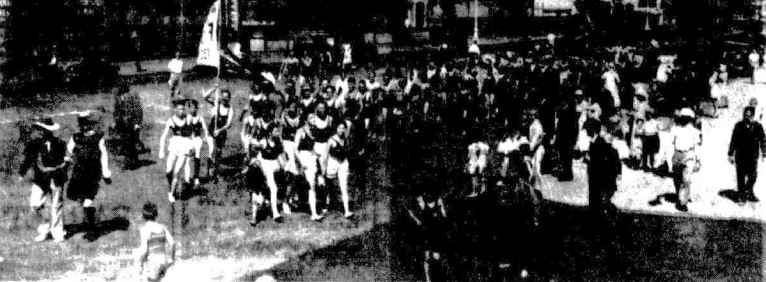The previous three iterations of Shrine to Sea’s Celebrating Local Stories series have emphasised the impact that the landscape has had on the community in the boulevard and surrounding areas. With the Albert Park Lake, the Kerferd Road Pier, and beaches all close by, it’s no wonder that water recreation has become embedded in the identity of the area. In Part 4 of the series, we explore how these water-based areas shaped the community. From providing crucial dietary sustenance for Traditional Owners to popularising learning to swim, from play to peril, sea bathing to social classes, the history behind these areas is bound to make a splash.
Lakeside sustenance
Prior to settlement and the formation of Albert Park Lake, Traditional Owners built fish traps at the edge of lakes and lagoons, and harvested plants such as the tuber Murnong and Yam Daisy, which was a mainstay of their diet. The East Kulin People, who lived in the former lagoon, also caught yabbies (freshwater crayfish), known as Tarlukpurne (or Tar-luk-purn).
Though the formal lake was designed in the 1860s as an ornamental feature of the emerging city, it remained a wild place, attracting a range of birds, and was ‘the haunt of numerous wild fowl’.

For children living in the built-up inner areas of South Melbourne and Albert Park, Albert Park Lake was an inviting, wide-open space that could be explored. The area became a vast playground for games and adventures, including making boats to sail on the lake.
Yabbying continued in the area’s modern use, where children would use a line of string tied with small piece of meat as bait. Children would take home a catch of yabbies to supplement the family meal.
Play and peril at Kerferd Road Pier
The Kerferd Road Pier, built 1887-89, remains a rare example of a pier designed exclusively for recreational use. This was unusual for the time, as most bayside piers were built to accommodate fishing vessels or, in the case of Station Pier, for transporting people and goods.
The pier is also credited with a role in the development of the Albert Park foreshore as a fashionable seaside resort. Helping to grow the popularity of sea-bathing, boating and other seaside recreation activities in the late nineteenth and early twentieth centuries.

However, when the pier was initially built, the majority of people in Melbourne were unable to swim so, while a recreational pier encouraged swimming, it also posed a significant public risk of drowning.

Tragically, the pier at Kerferd Road was the scene of a number of drowning accidents and several dramatic rescues.
One tragedy that captured the public’s attention was the death of a young man William Robert Satchell, aged 21, of Middle Park. Satchell leapt from the Kerferd Road Pier to rescue a young woman, Hannah McLennon, who had jumped into the water after drinking a vial of poison, determined to end her own life. Satchell was unable to bring the woman to safety and sadly they both drowned. A public fund was established so that a memorial in Satchell’s honour could be erected in the Melbourne Cemetery.
Learning to swim
Swimming competency became top-of-mind around this same time, as the Middle Park Baths, located at the end of Armstrong Street, were opened in the 1890s to encourage swimming for both men and women. Regulations were drawn up in 1912 that stipulated separate times for men and women’s swimming. Women’s allocated time was limited, while men were given exclusive access all day on Sundays and on Public Holidays.
The Middle Park State School instigated swimming lessons for its students in the 1920s where a local teacher ran lessons from the baths and Kerferd Road Pier. Annual swimming competitions and local swimming carnivals were also held at the pier.

In 1929 the Melbourne Herald newspaper launched its Learn-to-Swim campaign, with an opening event held at the Kerferd Road Pier where displays of swimming, diving and water sports drew large crowds. Young Victorians were awarded a Herald certificate after demonstrating that they could swim for 25 yards. The swim program was supported by the local South Melbourne council and ran for five-to-six decades.

Drawing a line in the sand
Middle Park Beach was considered public space but nevertheless, a space that became subtly divided, serving particular groups for particular activities. Class divisions were reflected in the ways in which the beach and the pier were used and occupied.
Middle Park Beach and Kerferd Road Pier provided for a range of water-oriented activities and were a place of social interaction. In general, Middle Park Beach was more middle class than Port Melbourne, but in the summer months, Middle Park Beach was popular with all classes, albeit with some social segregation according to class.

The pier also attracted a wide spectrum of local people, and on weekends it was a popular place for promenading. Despite the pier’s recreational functionality, it was also a place where food could be obtained. The working class used the pier for fishing and for gathering mussels to provide additional food for their families.
This continued a long legacy formed by the Traditional Owners, who had gathered mussels at the beach for thousands of years and continued to do so at Middle Park through the mid-twentieth century.
A vibrant district
Today, the beach areas along Port Phillip Bay are popular with swimmers and boaters, drawing in locals and tourists alike. The foreshore areas offer a thriving hub for businesses, and space for visitors to lounge, picnic, walk, and bike ride.
 Women at Albert Park Beach, c1960s (Source: Museum Victoria)
Women at Albert Park Beach, c1960s (Source: Museum Victoria)
As for Albert Park Lake, you can read all about the history of its formation and varied use throughout the decades here: https://www.environment.vic.gov.au/shrine-to-sea/celebrating-local-stories/part-2-changing-landscape.
This is just one of many exciting historical stories from the local Shrine to Sea area. Stay tuned for our final story celebrating the area's exciting history.
Page last updated: 13/12/22